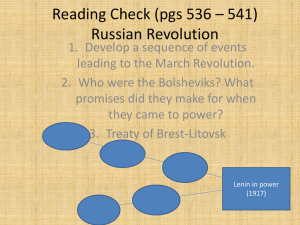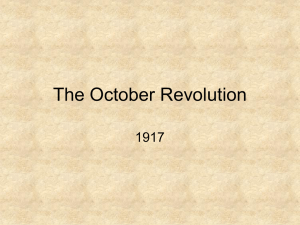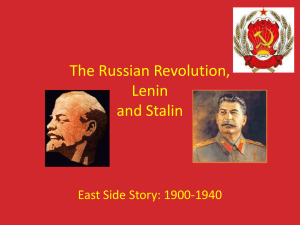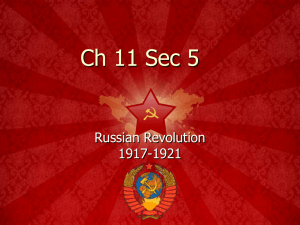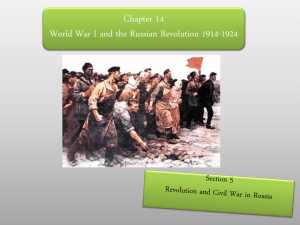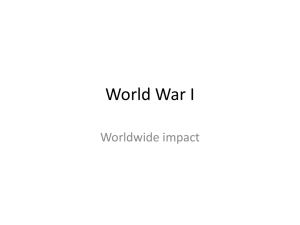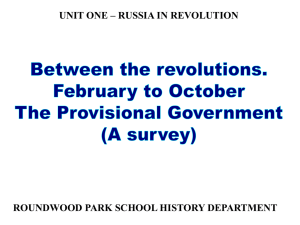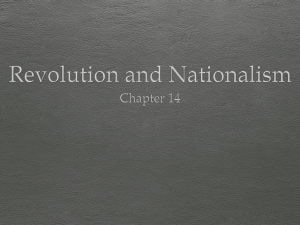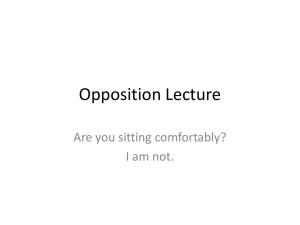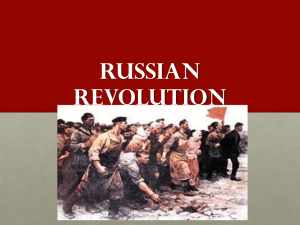Russian Revolution PPT
advertisement
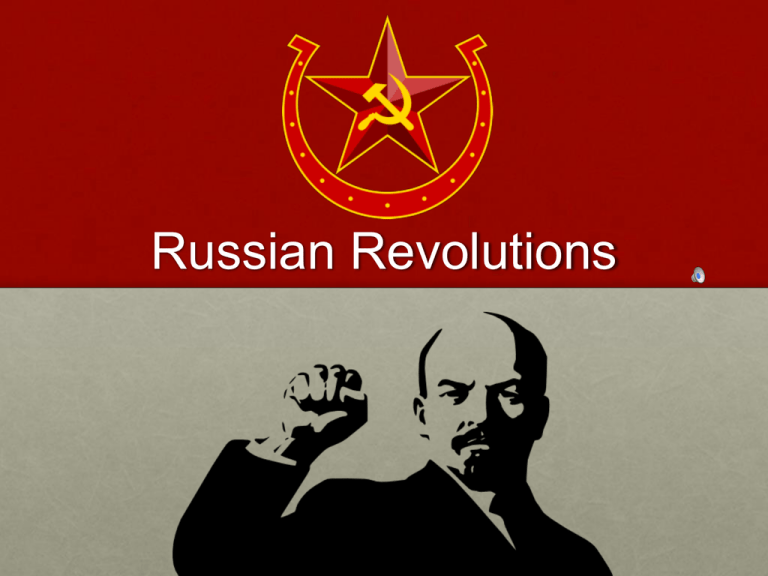
Russian Revolutions Key Causes: New Society • Growing Urban Workforce • The industrial revolution came to Russia largely in the 1890s industrialized society • Development in Russia was not as advanced as Britain • Russia’s cities began to expand and large numbers of peasants moved to the cities to take up new jobs and were in tightly packed and expanding urban areas experienced problems like poor and cramped housing, bad wages, and a lack of rights in their jobs • The government was afraid of the developing urban class • Even more afraid of powerful foreign investment away by supporting better wages, and the consequent was a lack of reforming legislation. Key Causes: New Society • Still1890s: • Russia develops an educated, political culture among a group of people who were forming between the aristocracy and the peasants • This group were part of a ‘civil society’ which sent their youth to be students, read newspapers, and looked towards serving the public rather than the Tsar • A severe famine in the early 1890s • Showed how ineffective the Tsarist government now was • Showed them how much they could achieve if they were allowed to unite • Tsar refused to meet their demands many of this social sphere turned against him and his government Key Causes: Bad Government • Tsarist Autocracy and a Lack of Representation • Russia ruled by Tsar • • • • • • Held by the Romanov family. Ruled alone Freedom of expression was limited The result was an autocratic regime under which republicans, democrats, revolutionaries, socialists and others both chaffed and were increasingly desperate for reform Some wanted violent change, others peaceful, but as opposition to the Tsar was banned, opponents were increasingly driven to extreme measures. The Tsar - Nicholas II: • • Determined to govern but lacked ability to run an autocracy correctly Went back to seventeenth century an almost late-medieval system (rather than reforming and modernizing Russia) • Strong reform movement in Russia (essentially westernizing) during the midnineteenth century under Alexander II. A constitution was being written when Alexander II was assassinated in 1881. His son, and his son in turn (Nicholas II), reacted against the reform, not only halting it but starting a counter reform of centralized, autocratic government. Key Causes: Bad Government • Unsuccessful Government • The late Tsarist government was not good • There was a mass of competing bodies out of whose confusion law, judgment and government decisions appeared entirely arbitrary, random, or reliant on patronage • Russia was under governed • Peasants had little contact with the imperial government • Government had to go through landed nobility • Zemstovs • peasant emancipation landholders declined and turned on the government, demanding reform Rulers did not have an idea of the peasant view, Peasants were not involved with the government Didn’t care about the wiping away of the whole Tsarist regime (in 1917) Timeline: Stage 1 • 1890: An imperial decree subordinated the zemstva to the authority of the appointed regional governors. • 1891: Severe famine affects almost half of Russia's provinces • 1904-1905: Loss in the Japanese-Russo War • 1914-1918: Big losses in WWI • Cost of bread skyrockets • Food shortages Timeline: Stage 2 • 1894-1917: Weak leadership of Nicholas II • Tries to crush the Duma (Parliament) • 1917: Censorship of all anti-government activities • December 1917: Red Terror led by the secret police known as Cheka • Eliminate all opponents to Lenin like Reign of Terror and Committee of Public Safety Timeline: Stage 3 • 1905: Bloody Sunday: a peaceful protest of 200,000, but guards open fire and kill 1000 • 1916: • Assassination attempts and final assassination of Rasputin • 1917: • February/March Revolution: 10,000 working class women led a series of strikes in Petrograd and St. Peterburg chanting “Peace and Bread” and “Down with Autocracy”---similar to Women’s Bread March on Versailles • All factories shut down and go on strike in Petrograd and soldiers join in • October Revolution: • Menshevik and moderate Soviets representatives walked out to protest the October Revolution. The Congress established, and Lenin its first chairman, to run the country between sessions. Timeline: Stage 4 • 1917: • Civil War in Russia-brought on primarily over continued involvement in World War One • Whites: anti-communists and supporters of the Provisional Government like the Girondins • Reds: communists-Bolsheviks like the Jacobins • Liberals: made up of the middle class and wanted a constitutional monarchy • Socialists: more democratic, did not follow Lenin, mostly peasants who wanted more land rights • Communists: radicals and followers of Lenin • Communists broken into Bolsheviks led by Lenin and Mensheviks led by Trotsky • Kornilov Affair Timeline: Stage 5 • 1917: Provisional Government led by Alexsandr Kerensky • Moderate republic • Duma met on March 12, 1917 to establish a Provisional Government made up mostly of the middle class like the National Assembly and later the Legislative Assembly • 1918-1921: Had Czar Nicholas II step down and got rid of the monarchy like at the end of the Legislative Assembly Timeline: Stage 6 • Development of Soviets---workers’ councils to give the working class a voice because they feel the Provisional Government does not represent them • October 1917: Lenin succeeds in taking over Timeline: Stage 7 • March 1918: Lenin led the Bolsheviks and changed the name of his political party to the Communist Party. • 1918-1921: Lenin still led the split political party of the Russian Social-Democrat Labor Party, and his party soon moved in and took control of Russia. Timeline: Stage 8 • Lenin dies in 1924 by natural causes • The Politburo is created---a seven member ruling government from membership of the Communist Party like the Directory • Land given to peasants • New Economic Policy • Workers given control of factories • Gave women equal rights and pay • Legalized abortions Timeline: Stage 9 • 1918-1921: • • • • • Execution of entire royal family without a trial Creation of Labor Camps and Gulags 8 million people sent to the camps and gulags 5 million were killed Complete censorship of all forms of communication Timeline: Stage 10 • 1922-1924: • Power struggle about who would lead next between Trotsky and Stalin • New middle class of young men from the working class newly educated and loyal to Stalin Key Figures Vladimir Lenin • Born April 22 1870 – Died January 21 1924 • “All power to the soviets” – Slogan (manipulated soviets) • Lenin was a revolutionary leader who returned from exile in 1917 to facilitate support for the Bolsheviks • He advocated an armed rebellion to establish a communist state – Agitated the masses against the provisional government – He instigated multiple large street demonstrations • Alienated most of the other prominent socialists, since he believed the Bolsheviks should rule • Used soldiers frustrations with the provincial government’s handling of WW1 to his advantage. He wanted immediate exit of the war.(greatly increased his support by the masses) • he launched an aggressive propaganda campaign directed specifically at the Russian troops still serving on the front. • His troops took over in nearly a bloodless coup on October 25, 1917 • Fought(won) civil war against the Whites(conservatives) • Lenin introduced a new economic policy on State Capitalism (runs like capitalism but controlled by state) Alexander Kerensky • One of the most prominent leaders of the February Revolution. • Was one of the members of the provisional and was elected vice-chairmen of the Petrograd Soviet. • After a government crisis he became the Minister of war and a dominant figure in the newly formed socialist-liberal coalition government. • He continually pushed the war effort and lead an offensive against the AustroHungarian/German south army(proved to be a failure). • Following unrest in Petrograd during July 1917 he became Russia’s Prime Minister. He then appointed himself supreme Commander-in-chief. • Kerensky then on September 15 proclaimed Russia as a republic, an action which the provisional government was not aloud to do. • His philosophy of "no enemies to the left" greatly empowered the Bolsheviks and gave them a free hand, allowing them to take over the military arm or "voyenka" of the Petrograd and Moscow Soviets. During the • During the Kornilov Affair, Kerensky distributed weapons to the Petrograd workers who in turn sided with the Bolsheviks who overthrew Kerensky in October • Was overthrown and sent into exile after the October Revolution in 1917 Leon Trotsky • Was an important leader of the Mensheviks but quickly joined Lenin after the October Revolution • Became second in command under Lenin • Lenin appointed Trotsky to the position of People’s Commissar of Foreign Affairs, which made Trotsky responsible for creating a peace treaty that would end Russia's participation in World War I. • After that Trotsky became the people's commissar of army and navy affairs in March 1918, placing him in charge of the Red Army. • After Lenin died Trotsky was politically outmaneuvered by Joseph Stalin and did not become Lenin’s successor. He was soon exiled from the Soviet Union and was eventually assassinated by Stalin’s orders. Nicholas II • Born May 18 1868 – Died July 17 1918 • He was the last Russian Czar • He abdicated the throne after the February Revolution got out of hand • He was executed in July 1918 when the Bolsheviks feared he would inspire conservatives to regain power. Joseph Stalin • Not particularly important in the October revolution but became a prominent member of the Bolsheviks after Lenin’s return in 1917. • Was Lenin’s commissar of nationalities • After the revolution Stalin became increasingly powerful and became Lenin’s successor over Leon Trotsky Results • Q1: The ideals did change during this revolution as the leaders changed. The provisional government established after Czar Nicholas’ abdication was never unified on an issue. They bickered frivolously and never seemed to accomplish anything. Their failure to accomplish dramatic change (especially in WW1) lead to Lenin and the Bolsheviks coming to power. The Bolsheviks then held true to their ideals and took Russia out of WW1. Lenin also changed his values while seeking power. - While Lenin gauged the Russian masses for revolution he continually changed his stance on various different issues to gain more support. For example he eventually embraced the Petrograd Soviet even though he only wanted the Bolsheviks to gain power. Results cont. • Q2: Most original goals of the revolution were not achieved. - When the soldiers(millions) returned home from WW1 they were tired, hungry, and wanted jobs. However there was no surplus of food due to the fact that since there was no private land ownership, farmers only grew enough produce for themselves. Thus there was no incentive for them to make extra to sell. So the Russian people did not receive the Land or food they were promised. • However this revolution did successfully bring an end to Russian intervention in WW1, thus facilitating the Peace Lenin promised. In addition to this the revolution did bring about the rule of the Bolsheviks; one of Lenin’s main goals. Results cont. • Q3- Though it seemed as if the working class (Proletariat) was going to gain a significant amount of power they did not. This was because the Bolsheviks failed to provide the bread and land they promised to the people. Thus the lower class people were not elevated in the heavily land based Russian society. In addition to this all social classes suffered from the impending civil war between the Reds(Bolsheviks) and the Whites(conservatives). After the revolution was done about 1.5 million soldiers and 13 million civilians died. Results cont. • Q4- Politically, the Russian Revolutions brought about the end of autocratic rule in Russia and the establishment of a socialist/communist government. Militarily it brought about the withdrawal of Russia from WW1. Economically the revolutions other than bringing about some industrial growth, did relatively little to stimulate the economy. Socially, as stated earlier, the revolution did not change much due to the civil war that resulted. Sources • Bunyan, James and H. H. Fisher. “The Bolshevik Revolution.” Stanford University Press. Demand Media, n.d. Web. 2 April 2014. • Grey, Ian. “The First Fifty Years.” Coward-McCann. Demand Media Inc., New York, 1967. Print. 2 April 2014. • Matthews, Roy T. and F. DeWitt Platt. “The Western Humanities.” Third Edition. Mountain View. Mayfield Publishing Co., 1997. Web. 28 March 2014. • McNeal, Robert H. “The Bolshevik Tradition.” Prentice-Hall, Inc. Englewood Cliffs, New Jersey. 1975. Web. 2 April 2014. • “Leon Trotsky.” About.com 20th Century History. N.p., n.d. Web. 4 April 2014. • WHAP Homepage

